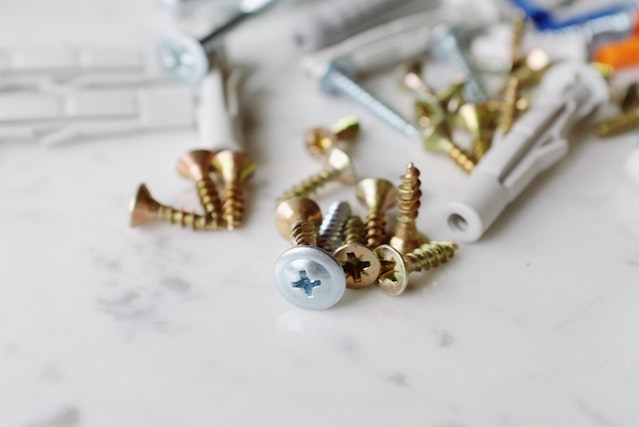
Why are there many different types of screw head? The different types of screw head allow for different amounts of torque and for use by different machines. There are over 30 different types of screw head.
Prehistoric people generally joined things together using adhesives. The earliest known adhesive was a tar made from heating birch bark. An example has been found from 50,000 years ago and it was used to fasten things like axe heads to sticks. There are some cases, such as house building, where an adhesive isn’t enough. Early cultures, such as the Egyptian, Chinese, and Mesopotamian, used mortise and tenon joints from about 3100 BC. These are very effective, but they take time, labor, and skill to make.
The concept of a screw appears in Greece by about 400 BC. Nobody knows who came up with the idea. It is attributed to several people, one of whom being Archimedes. However, this was not a screw in the sense of a fastening screw. Archimedes’ screw was an early form of pump that drew water up using a screw mechanism turned by hand. He also made a screw machine that turned rotational motion (with a handle) to linear motion (using a screw). Screws were also used in the olive presses and wine presses.
The bolt and screw was invented in 1568, but machines were imprecise, and it was very difficult to make the bolt exactly fit the screw. If a bolt did fit a screw, it had to be kept on that screw because there was not much chance that another bolt made on the same machine would fit it. This only became possible after the Industrial Revolution with the introduction of precision machining. It wasn’t until 1840 that screw threads were standardized, meaning you could buy multiple screws and bolts that would be interchangeable.
So, why are there so many types of screw head? The first type of screw had the slotted head that is fitted by a flathead screwdriver. These types of screw are the easiest to make and they work fine when being tightened with a handheld screwdriver. The trouble came when powered screwdrivers were invented. The powered screwdriver finds it very difficult to grip the slot and it is difficult to deliver much torque to the screw. Torque is a twisting force and if the screwdriver is not centered in the screwhead, there is a lot of wasted force.
Phillips screws were invented as a solution to the problem of industrial screwdrivers not being able to grip the screw. The Phillips screw has a cross cut into it that automatically centers the driver. Interestingly, the Phillips screw was not invented by somebody called Phillips. It was invented by John P. Thompson in 1932, but he couldn’t get any manufacturers to make it for him because the new shape would require more difficult and more expensive manufacturing techniques than the simple slot screw that everybody used. In the end, he gave up and sold his design to Henry Frank Phillips, who went on to manufacture the screw and put his name to it. Phillips saw the potential of the screw that the other manufacturers didn’t see. Not only is it self-centering, but there are also more points of contact so more torque can be applied than a regular screw. The Phillips screw head solved several problems regular screws had, but it is not perfect.
One of the main problems that happens with Phillips screws is something called “cam-out”. This is when the amount of torque the driver is producing exceeds the amount of torque the screw can take, and the drill bit slips out of the screw. This can scratch the thing you are trying to screw or chew up the cross part of the screw, making it impossible to remove. An improvement on the Phillips screw was a screw with a six pointed cut in the top of it. This required different drill bits, but there are more points of the contact with the screw, and it makes slippage much less likely. Modern powered screwdrivers also have a clutch that removes power to the driver if the torque limit is reached. The trouble is, as the head of the screw gets more complicated, the manufacturing costs increase.
Another alternative screwhead is the hex screw tightened with an Allen key. These bolts and screws have a hexagonal shape cut into the top of them and can only be tightened with a corresponding drill bit or key that is the same size. These were popularized when William G Allen obtained a patent for the wrench, hence the name. Because of the shape, the key fits snugly in the recess and there is no slippage. They are also very cheap to make, which is why they are so often included with self-assembly furniture kits.
The next introduction of screwheads, and probably the reason why there are so many different types now, came about with the invention of new technology, such as cars. Often, manufacturers will use screws that only they can untighten in their machines so that people have to return to the original shop for servicing. It doesn’t take long for other companies to make a driver that fits, but this has greatly inflated the number of screwheads out there. An example is a hexagonal bolt with a raised dot in the center so that you cannot use a regular Allen key.
So, the basic types of screws are the slot and the Phillips, although there are many others. In reality, different situations would call for different types of screw, but in reality, most people just use Phillips. And this is what I learned today.
Sources
https://en.wikipedia.org/wiki/Screw
https://www.wagnermeters.com/moisture-meters/wood-info/history-of-woodworking/
https://www.fordfasteners.com/a-brief-history-of-fasteners/
https://hausoftools.com/blogs/news/who-invented-the-screw-and-how-has-the-screw-evolved
https://www.hitchcockandking.co.uk/h-k-news/what-are-the-different-types-of-screw/
